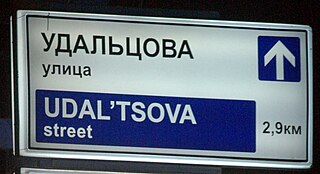An interpunct(·), also known as an interpoint, middle dot, middot and centered dot or centred dot, is a punctuation mark consisting of a vertically centered dot used for interword separation in ancient Latin script.. It appears in a variety of uses in some modern languages and is present in Unicode as U+00B7·MIDDLE DOT.

Romanization or romanisation, in linguistics, is the conversion of text from a different writing system to the Roman (Latin) script, or a system for doing so. Methods of romanization include transliteration, for representing written text, and transcription, for representing the spoken word, and combinations of both. Transcription methods can be subdivided into phonemic transcription, which records the phonemes or units of semantic meaning in speech, and more strict phonetic transcription, which records speech sounds with precision.
Devanagari is an Indian script used for many languages of India and Nepal, including Hindi, Marathi, Nepali and Sanskrit. There are several somewhat similar methods of transliteration from Devanagari to the Roman script, including the influential and lossless IAST notation.
ISO 9 is an international standard establishing a system for the transliteration into Latin characters of Cyrillic characters constituting the alphabets of many Slavic and non-Slavic languages.

The romanization of the Russian language, aside from its primary use for including Russian names and words in text written in a Latin alphabet, is also essential for computer users to input Russian text who either do not have a keyboard or word processor set up for inputting Cyrillic, or else are not capable of typing rapidly using a native Russian keyboard layout (JCUKEN). In the latter case, they would type using a system of transliteration fitted for their keyboard layout, such as for English QWERTY keyboards, and then use an automated tool to convert the text into Cyrillic.
ISO 15919 "Transliteration of Devanagari and related Indic scripts into Latin characters" is one of a series of international standards for romanization by the International Organization for Standardization. It was published in 2001 and uses diacritics to map the much larger set of consonants and vowels in Brahmic and Nastaliq scripts to the Latin script.
The romanization of Ukrainian, or Latinization of Ukrainian, is the representation of the Ukrainian language in Latin letters. Ukrainian is natively written in its own Ukrainian alphabet, which is based on the Cyrillic script. Romanization may be employed to represent Ukrainian text or pronunciation for non-Ukrainian readers, on computer systems that cannot reproduce Cyrillic characters, or for typists who are not familiar with the Ukrainian keyboard layout. Methods of romanization include transliteration and transcription.
The Royal Thai General System of Transcription (RTGS) is the official system for rendering Thai words in the Latin alphabet. It was published by the Royal Institute of Thailand.

The Hebrew language uses the Hebrew alphabet with optional vowel diacritics. The romanization of Hebrew is the use of the Latin alphabet to transliterate Hebrew words.
Romanization of Greek is the transliteration (letter-mapping) or transcription (sound-mapping) of text from the Greek alphabet into the Latin alphabet.

The romanization of Arabic is the systematic rendering of written and spoken Arabic in the Latin script. Romanized Arabic is used for various purposes, among them transcription of names and titles, cataloging Arabic language works, language education when used instead of or alongside the Arabic script, and representation of the language in scientific publications by linguists. These formal systems, which often make use of diacritics and non-standard Latin characters and are used in academic settings or for the benefit of non-speakers, contrast with informal means of written communication used by speakers such as the Latin-based Arabic chat alphabet.
ISO 259 is a series of international standards for the romanization of Hebrew characters into Latin characters, dating to 1984, with updated ISO 259-2 and ISO 259-3.
Romanisation of Bengali is the representation of written Bengali language in the Latin script. Various romanisation systems for Bengali are used, most of which do not perfectly represent Bengali pronunciation. While different standards for romanisation have been proposed for Bengali, none has been adopted with the same degree of uniformity as Japanese or Sanskrit.

Romanization of Persian or Latinization of Persian is the representation of the Persian language with the Latin script. Several different romanization schemes exist, each with its own set of rules driven by its own set of ideological goals.
ISO 11940 is an ISO standard for the transliteration of Thai characters, published in 1998 and updated in September 2003 and confirmed in 2008. An extension to this standard named ISO 11940-2 defines a simplified transcription based on it.
There are various systems of romanization of the Armenian alphabet.
The tie is a symbol in the shape of an arc similar to a large breve, used in Greek, phonetic alphabets, and Z notation. It can be used between two characters with spacing as punctuation, non-spacing as a diacritic, or (underneath) as a proofreading mark. It can be above or below, and reversed. Its forms are called tie, double breve, enotikon or papyrological hyphen, ligature tie, and undertie.
The romanization of Japanese is the use of Latin script to write the Japanese language. This method of writing is sometimes referred to in Japanese as rōmaji.
ISO 11940-2 is an ISO standard for a simplified transcription of the Thai language into Latin characters.




